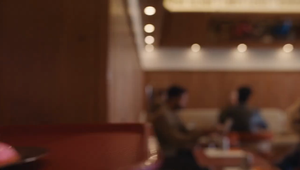
5 Minutes With… Doerte Spengler-Ahrens

As a girl, Doerte Spengler-Ahrens dreamed of being an artist, but after a rather blunt teacher quashed that particular aspiration she found herself working in the ad industry. She’s been with German super-agency Jung Von Matt for over a decade, now holding the position of CCO for Jung Von Matt/Fleet, the agency’s brand identity specialists. LBB caught up with Doerte at the LIA Creative Conversations to talk about the state of German advertising, the difficulties of attracting the best new talent to the industry and why she hates ‘greenwashing’.
LBB> What is it about Jung Von Mat that makes it so unique?
DS-A> I think that Jung Von Matt is different from other agencies because we are owner-led, which means we don’t belong to a network and the people who are leaders can make real decisions and don’t need to wait for approval. That’s something that is very important, not only for hiring people and deciding what clients we keep and don’t keep but because you can act on behalf of your own vision. You’re not dependent on other people.
LBB> How did you get into advertising?
DS-A> The simple truth is that I wanted to become an artist and at that time the teacher said you are not talented enough to be one, try advertising. Looking back you think ‘what, how can someone say something like this to a 17 year-old?’ but on the other hand I am very thankful because it helped me find my perfect job.
LBB> And you became a copywriter rather than an art director – did you have a greater affinity with writing, or was it because you’d been influenced by what your teacher had said?
DS-A> To be honest when you start your career you don’t normally know if you’re going to become an art director or a copywriter. I started studying visual communication and I thought that being an art director might be something I would quite like. Actually I started as an art director and switched to copywriting. And then, after a certain time you become a creative director and you have to do both and have all of the skills for film and digital. Writing is still a very important part – without the concept behind it, no one would ever buy your idea. Words are always going to be important, and so are pictures, and you have to be a pro in both.
LBB> When did you start at Jung Von Matt?
DS-A> I started my career at Jung Von Matt in the late 90s, and it didn’t become boring because I opened up several agencies for them, like the Berlin branch and our brand identity arm, Fleet. In between I worked in their international agency, which was different because we had international talent rather than German creative working for us. It was very interesting and I’ve kept that system for my current agency – in Jung Von Matt Fleet. I have been there for more than ten years.
LBB> So how does the Jung Von Matt system work – do all the branches operate as independent agencies?
DS-A> It’s a clever idea. Our owners had to make people more productive by letting them compete. Instead of having one huge agency of thousands of people we have many smaller agencies which include specialist outposts. The advertising, marketing and platform agencies compete on one campaign – they are all independent and responsible for their own results. That’s why they are all under pressure, with each fighting to produce great work.
LBB> In terms of the German market, what are the key challenges that you think are facing the industry?
DS-A> I hope that the economic crisis of Europe doesn’t hit us too severely. This is a menace that looms above us all. Greece, Spain, Portugal… they are all close to being bankrupt. Germany can’t balance this out alone with France for the whole European Union. I’m a little afraid that we are heading for the next financial crisis, which will of course affect the economy and that will affect us, the advertisers. You know what they cut short first, before they cut down on production!
However, I am very confident about the creative development of my country because I think we’ve shown improvement in the last year. We are not behind international standards, in fact, in some ways we are leading when it comes to creativity. On the other hand, what we have to keep pace with is digital development. I think Germany is a little bit behind – we have very few Twitter users here. In America it’1s millions, but we only have about 3 per cent of the population using it which is crazy.
LBB> At the end of your talk to the young creative at the LIA event, you told them to get in touch if they fancied working for you. How do you source creative talent for your agency? Why is it important to be pro-active in this way?
DS-A> I think it’s very important for us to be present at creative shows, then people say ‘hey that’s cool, I want to do that myself’. That’s not to be underestimated. I hope that our standard of work is attractive. Last but not least, I think it is important for people like myself go into universities and talk to young people. I am very active in the German Art Directors Club and hold seminars and congresses to motivate people to make contact with us. That works very well.
On the other hand, we have less and less young people, and a lot of them don’t want to come into advertising. The industry has lost its attractiveness. It’s really worrying, how do we get those creative, hungry, intelligent people into our industry? It’s very challenging.
LBB> And how do you develop and motivate young creative to help them mature and become more courageous in their work?
DS-A> Normally when you enter an agency you have a schedule and people help you meet your deadlines. So the motivation comes from something very simple – the need to come up with solutions within a deadline. The other thing is motivating people to go the extra mile by leading by example and showing them there’s always a better solution to the good solution and that it’s always worth putting in the extra effort. That’s part of the agency culture and I try to share it with my people.
LBB> What are your thoughts on corporate social responsibility and brands trying to really make a difference – are brands changing and is it sincere?
DS-A> I have to say I really like brands that are really socially responsible and try to give something back. I hate when brands do ‘greenwashing’ – when they pretend to do something good to balance out the bad things they’ve done. This is something that they just can’t get away with any more because consumers are now much more aware about what companies do. A good example is the Coca-Cola case we looked at in the LIA jury. The polar bear is in danger, the ice caps are melting… we all know this. What they did was spend a huge amount of money changing the colour of their can from red to white. I mean, who needs that? OK they spent $3 million dollars on polar bear conservation, but I’m sorry, $3 million sounds like a very small amount in comparison with the stunt to change the colour of all their cans. For what? And the funny thing is, as somebody pointed out, it was a massive flop because the consumer didn’t notice what this was all about and thought it was just Coke Light so they mixed up the cans and wouldn’t buy it.
That’s something I really must say – this is not where the future lies. The future is that brands really need to mean what they do and not just pretend. People have a really clear opinion on things and a gut feeling that tells them if something is rubbish.
LBB> Which pieces of work from your agency have particularly resonated with you recently and why?
DS-A> From my point of view I really like to show the ‘.wwf’ ’ campaign because not only did it take a huge amount of effort to get done, but it showed that sometimes communication is not communication. In that case it was a product. We came up with a kind of PDF file that was unprintable (a .WWF file) on behalf of the wildlife and conservation charity for paper conservation. It was a product idea, a PR idea, an initiative and a campaign all at the same time. That’s why I like it so much – it wasn’t a case of ‘let’s make an ad and people will change their mind’. People don’t change their minds very easily. It’s always better if you try to change people’s behaviour instead.















